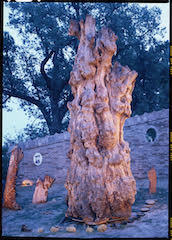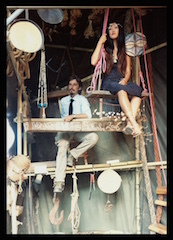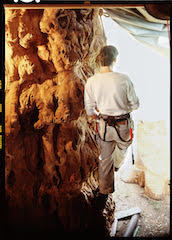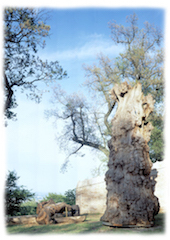Mattia Ruggeri was born surrounded by creativity and an appreciation of art. His father spent his life thinking about and studying art, and together the two Ruggieri worked on many catalogs and monographs still in circulation. Mattia shares wisdom from his father's deathbed: "When death came on time, have not fear, it is just a little wind," words that continue to inspire the artist to take on his larger-than-life work.
After years working on a 35-ton sculpture, Ruggeri has spent his career balancing a small art business with his own creative aspirations. He learned to sell small artifacts and maps to support his work, fighting for his piece the whole time. As he looks for the right kind of modern museum to house his incredible piece and the 16 years worth of artifacts that accompany it, he reflects on the journey that led him to create his life's greatest work.
Steve Mariotti: How did you know you wanted to be an artist?
Mattia Ruggeri: We lived in the hills of Bologna, where nearly artists would always be--sleeping on our floor, hanging out in our yard where I played, socializing at my parents weekly parties.
One of the discussions I overheard changed my life. I was 5 years old and I overheard someone say to my father, "art is dying." She was a Greek princess, dressed in all white with white hair to match. This was the 1970s and it was a pretty normal thing to hear--the avant garde was rejecting the idea of beauty. But to my five-year-old mind, art was an old and sick lady, neglected by these people all around me. It started a life-long motivation within me to create art and support other artists as much as possible.
SM: How did your family influence your interest in the arts?
MR: My father, Professor Ruggeri, was one of the most important art critic in Italy during the 1970s, 1980s and 1990s. He founded Bologna's Academy of Theater Acting and the Art Fair. He wrote many dozens of monographs on artists, and hundreds of articles about art in the most prestigious Italian newspapers. He discovered Luigi Ontani, now a world famous artist, when Luigi came to visit us at our home in Bologna. He inspired all of us in the family: my older sisters are in theatre, my other sister an art critic, and my brother a painter.
He taught me what Franz Kafka said about fate: "fate is an invisible rope stretched along our way a few centimeters from the ground, on which we often stumble." This spoke to my lifelong pursuit of art, my own fate.
SM: What was your relationship with your father like?
MR: We were best friends throughout my life until his death in 2001. He believed that children learned best through play and conversation. He would not let me do my homework--my job was to play and discuss ideas with my family. Many times he warned me about the mistakes in schoolbooks, and that children could believe their teachers too much. He always encouraged me to follow my own ideas and encouraged me to become an artist with absolute integrity.
SM: When did you first consider yourself an artist-entrepreneur?
MR: It was 1995 and I was 25 years old, making my living by selling my work throughout Italy. I was an entrepreneur as well as an artist.
One day, in the Bolognese woods, I saw a giant chestnut 6 meters tall and about a thousand years old. It was the biggest tree I had ever seen--standing dead in the forest like an ark, with a vacuum inside. I knew immediately that working on this tree would be a major part of my art and my life.
By August of 1998 I had the 14-ton tree transported to my studio. It was brought there one day by to a team of lumberjacks and my 85-year-old father, who said to me "I am so proud of you my son Mattia. Sculpturing this tree into a beautiful work of art is a work worthy of the new Michelangelo."
Over the next eleven months, I built a large studio around the sculpture and designed and built the tools I would need. Later a company with whom I worked on the tools, duplicated our set for the Guinness Book of World Records since they were the greatest tools for sculpting a tree. After three years, I moved my tree to an easier workspace in an old Romanesque church in the hills of Bologna. Amazingly, this church, the Hermitage of Ronzano, was mentioned by Dante in his Divine Comedy about the "Frati Gaudenti" and Loderingo degli Andalò. While there I met an art history graduate of Smith College, Sooin Yi. Since I spoke no English and she no Italian, we bonded over our love for ancient Italian art, we worked together, and eventually married and had a child.
SM: What are some of the challenges to working with such a gargantuan piece?
MR: The ark can take over your life. I lived on top the tree both in 2007 and 2012--these experiences left me uncomfortable and unable to sleep in a normal bed for a while.
Then, later in 2012, I became interested in the mysteries of the Great Pyramid of Cheope and the granite ark within known as Djed in ancient Egyptian. It was this form that later inspired Noah's ark. I commissioned the upper quarries of Carrara to grind 35 tons of statuary marble. I spent the next several years putting the marble inside the tree.
SM: How did you finish the piece?
MR: All in all, I devoted sixteen years to the tree and marble ark. I finished in March of 2015. People from all over Italy have come to see them and I believe that it is the greatest work of art I have produced. Throughout that time, my art business kept me afloat and proved to me the the entrepreneur is the artist of the business community.
SM: What is your advice for young and aspiring artists?
MR: My advice to young artists is to never compromise. Stick to your core values and your art no matter what. Conformism, masked as life, is a ravenous desire of the spirit to be similar to others out of fear of being alone.





